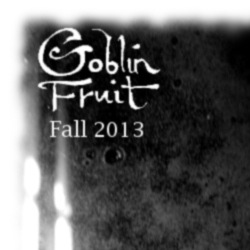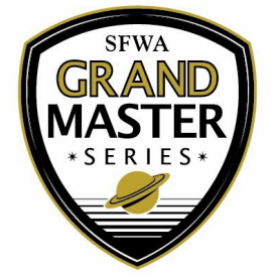 Amal El-Mohtar is the Nebula-nominated author of The Honey Month, a collection of spontaneous short stories and poems written to the taste of 28 different kinds of honey. She is a two-time winner of the Rhysling Award for Best Short Poem (“Peach-Creamed Honey” and “Song for an Ancient City”), and edits Goblin Fruit, an online quarterly dedicated to fantastical poetry. Her short fiction and poetry have appeared in multiple venues online and in print, including Strange Horizons, Stone Telling, MythicDelirium, Glitter & Mayhem (Apex Books), Steampunk III: Steampunk Revolution (Tachyon), The Thackery T. Lambshead Cabinet of Curiosities (Harper Voyager), and The Year’s Best Science Fiction and Fantasy 2011 (Prime Books). She currently lives in Glasgow. You can find her online at https://amalelmohtar.com.
Amal El-Mohtar is the Nebula-nominated author of The Honey Month, a collection of spontaneous short stories and poems written to the taste of 28 different kinds of honey. She is a two-time winner of the Rhysling Award for Best Short Poem (“Peach-Creamed Honey” and “Song for an Ancient City”), and edits Goblin Fruit, an online quarterly dedicated to fantastical poetry. Her short fiction and poetry have appeared in multiple venues online and in print, including Strange Horizons, Stone Telling, MythicDelirium, Glitter & Mayhem (Apex Books), Steampunk III: Steampunk Revolution (Tachyon), The Thackery T. Lambshead Cabinet of Curiosities (Harper Voyager), and The Year’s Best Science Fiction and Fantasy 2011 (Prime Books). She currently lives in Glasgow. You can find her online at https://amalelmohtar.com.
Diane Severson Mori for Amazing Stories Magazine (ASM): Thank you so much for joining us on Amazing Stories Magazine! I’m very excited about interviewing a young, up-and-coming poet and publisher like yourself. We read your official bio above, but we’d like to know more! What can you tell us about how you came to poetry?
Amal El-Mohtar (AE-M): When I was about seven years old or thereabouts, I was living in Beirut and reading anything with pages. I loved the italicised bits in The Hobbit, and the language in my children’s version of A Midsummer Night’s Dream, so I wrote a poem to the moon full of thees and thous and rhymes like “light” and “plight.” My parents encouraged me, telling me about my grandfather who was a poet imprisoned and tortured for his politics, telling me that poetry (and, I guess, rebellion) ran in my blood. My father taught me about rhythm by reciting lines from Shakespeare’s sonnets with full iambic emphases. I grew up taught that poetry was something to speak aloud and be proud of, and I’m very grateful for that.
ASM: Where can we read your most recent publications?
AE-M: My most recent poem was “This Talk of Poems” at the shiny, new incarnation of Mythic Delirium in September, and before that, “Lost” in Strange Horizons; my most recent fiction is a novelette called “A Hollow Play” in Glitter & Mayhem, edited by Lynne Thomas, Michael D. Thomas, and John Klima.
ASM: That’s a great collection of recent works. A little Googling comes up with a wealth more. What are you working on right now?
AE-M: The fall issue of Goblin Fruit (editorial note: this just went live), some non-fiction commissions, and stories about map-speakers and near-future role-playing—but I also recently made the (momentous for me) decision to start writing a novel this year, and the decision on its own has me kind of excited. I’m also working on raising my deadlift from 90 kg to 100 kg and struggling on the path to achieving an unassisted overhand grip pull-up.
ASM: Wow, a novel—that’s fantastic! I’m looking forward to hearing more about that as it progresses. Let’s look at your work as one of the editors of Goblin Fruit. The journal focuses on poetry “of the fantastical”. Poetry that treats mythic, surreal, fantasy and folkloric themes, or approaches other themes in a fantastical way. (Lifted directly from the guidelines of the site). How did you decide to concentrate on that type of poetry?

AE-M: At the time (early 2006), Jessica P. Wick and I were seeing loads of venues publishing science fiction poetry and “scifaiku” but not seeing much that was to our taste—and in venues that published a variety of different kinds of poetry, such as Strange Horizons, Mythic Delirium, and Ideomancer, our favorites were consistently the fantastical ones. Ultimately the language of the mythic, the magic, the fairy tale was a language that we shared and loved, the language in which we wrote our own poems and stories. Once Jess came up with the name, we felt our aesthetic snap into place.
ASM: How much time do you spend in your capacity as editor? Do you and Jessica Wick (co-editor) have different roles or tasks you perform? Is it a labor of love or do you earn any hard cash?
AE-M: Most of the time, I spend probably about 3-5 hours a week going through slush, answering queries, and communicating with artists about issue art; in the couple of weeks preceding an issue’s launch, it’s more like 15-20 hours spent wrangling code, organizing the table of contents, uploading sound files, writing the “Note from the Editors,” and, if we have a feature, writing interview questions and a brief bit of context for the poet being featured.
It used to be that Jess and I would read everything separately, since there were always at least 3 hours’ difference between our time zones (at least 3, at most 12! I’ve moved around a lot the past 6 years) and coordinating was tricky. So I’d go through, write up potential rejections and acceptances, go to sleep, and let her either agree or disagree with my assessments; she’d do the same thing for me. But as the volume of submissions we received began to skyrocket around 2008-2009—just as I was beginning a doctoral program!—we decided to trust each other on the rejections and just discuss the stuff we wanted to accept or were unsure about.
Jess has been on break from editing since April 2012, and around that time I invited Caitlyn Paxson, a mutual friend and former Goblin Fruit contributor (as well as novelist, oral storyteller, and artistic director!) to join the team. The way the editing works now is that Caitlyn Paxson does a first pass through all the unread slush, rejects what is obviously not a good fit, and marks up the work she likes or is ambivalent about for me to see. I then go through it as time allows (which has been in rather a short supply for the last two years as I work on this degree.)
It is indeed a labour of love; none of us are paid. Donations received from generous readers over the last four years have succeeded in keeping us from delving into our own pockets, which is all we ever hoped to achieve with it financially; we just want it to exist in the world.
ASM: Do you also solicit poetry or do you select from what’s been submitted to you and go from there? What do you expect from the poetry submitted to you?
We do also solicit poetry, though less and less lately as the slush pile roils and swells like a wordy sea; we expect poetry that, as Jess once put it, “sings to the gut,” that hooks us and strikes us and sinks into memory. We also expect the poetry submitted to us to not be bigoted, racist, sexist, or homophobic, at bare minimum.
ASM: Do you ever work with poets to improve a poem you think has merit but is not quite ready for publication? What does that kind of work usually entail?
Sometimes, when we really love a poem except for a line here or there, a very specific criticism, we’ll offer a conditional acceptance provided the change is made; other times, when the problems are more diffuse but probably workable within a second draft, we’ll recommend lines along which to rewrite and re-submit a piece. This is becoming increasingly rare as our submission volume increases, and with it, the number of heart-stoppingly-perfect-as-they-are poems.
ASM: Who maintains the website and does the formatting, etc.?
At the moment, me! But I’m only able to do so through the good offices of Dmitri Zagidulin, whose kindness, patience, and generosity substantially changed Goblin Fruit’s overall design in 2009, making it much easier for the less technically literate among us to work with the code.
ASM: You also feature wonderful fantasy art on the website. Do you solicit the artwork? Do you compensate the artists for their contribution (as you do the poets)?
We do indeed solicit the artwork. Up until Winter 2012, Oliver Hunter was our primary artist and artistic director, sometimes choosing to showcase the work of other brilliantly talented people such as Roseau and Fam. He’s working on millions of creative projects at the same time, as is his wont, so we’ve now got a rotating roster of wonderful artists such as Betsie Withey, Elisabeth Heller, Rose Lemberg, Paula Friedlander, Galen Dara, and Orion Zangara contributing their work to the ‘zine.
We pay our artists, like our poets, a token amount, while wishing fervently we could pay them what their work is worth to us—a sum reckoned in princes, pomegranates, and their weight in gold.
ASM: Indeed! I’ve always thought that poets should be paid their weight in gold. You feature a lot of poetry and art by women (it seems). In fact, the winter 2013 issue seemed to be an all-female production. Is that a conscious effort to balance out the seemingly male domination of most other poetry publications or is it just coincidence? If so, what do you think the reason for that is?
AE-M: I have been meaning for some time to try and do a proper number-crunching of submissions and proportional acceptance rate, but there are numerous snags: a name is a chancy thing to go by in determining gender, and many contributors prefer to go by initials; we recognize more than two genders; and we feel it’s impolite to go poking about in people’s identities to satisfy our curiosity on the matter of submission stats.
We do not set out consciously to showcase mostly work by women, but we’re always glad to see it happen; as you point out, the field is indeed pretty dominated by (straight, white) men, and we’d rather not perpetuate that imbalance. Without crunching numbers, and bearing in mind the above-mentioned caveats, my sense is that the majority of submissions we receive—probably about three quarters of them—are from people who use female pronouns. There could be many reasons for that; the gendering of “fantasy” as a more female genre than hard, manly science fiction; the fact that our editorial team is made up of women, and so women potentially see us as more approachable; the fact, too, that “fantastical poetry” is a broader umbrella than “science fiction poetry” such that we get a wider range of people submitting. We’d love to see more submissions by men—our Fall 2013 issue contains a feature on Mike Allen’s poetry, and Joshua Gage was, along with Sonya Taaffe, one of the first contributors to have published 10 poems with us outside of a feature—but if we were going to make a conscious effort at balanced gender representation we’d want to start by deliberately seeking out more work by genderqueer and neutrois people first.
ASM: Thanks for that. It would behoove me not to assume a gender by the name, but I’m glad I wasn’t totally off base. I know you read a lot of poetry beside what appears on Goblin Fruit. Which poets do you admire? Which have inspired you? Do you have any recommendations for new poets we should keep our eyes open for? Any favorite journals (online or in print)?
 AE-M: So many poets! Thank goodness you specified “beside what appears on Goblin Fruit,” because if I can keep from rattling off the names of all our contributors that’s a good start. (But seriously, all our contributors!)
AE-M: So many poets! Thank goodness you specified “beside what appears on Goblin Fruit,” because if I can keep from rattling off the names of all our contributors that’s a good start. (But seriously, all our contributors!)
Rose Lemberg, Shweta Narayan, Sonya Taaffe, and Sofia Samatar have been relentlessly dazzling me over the last two years with their poetry, and Rose and Shweta have been further astounding me with the tremendous work they do in Stone Telling. From its first issue in 2010, Stone Telling has become one of my top three poetry journals—the others being Strange Horizons (where the new poetry team is composed of Adrienne J. Odasso, Sonya Taaffe, and Romie Stott, who are doing great things), and Mythic Delirium, which has recently had something of an online renaissance and is beautiful to behold.
Outside of the genre community but still writing what I consider fantastical verse, I adore the poetry of Robin Robertson (especially “Swithering”) and Lisel Mueller (especially “Alive Together”). As to new poets, I’ve just discovered Katherine McMahon through a local friend, and am reading her chapbook, Treasure in the History of Things, and very much enjoying it.
ASM: Amal, I’m so pleased and it was such a pleasure to interview you. I’m looking forward to your next collection of poetry (hoping that comes sooner rather than later!) and to that novel! In the meantime I will continue to follow your work published in the ether and enjoy your wonderful Goblin Fruit. Thank you!
Please also read Amal’s fascinating blog post “Of Ordering Poems and Smithing Locks: Thoughts on Editing” on the putting together of an issue of Goblin Fruit.











Recent Comments